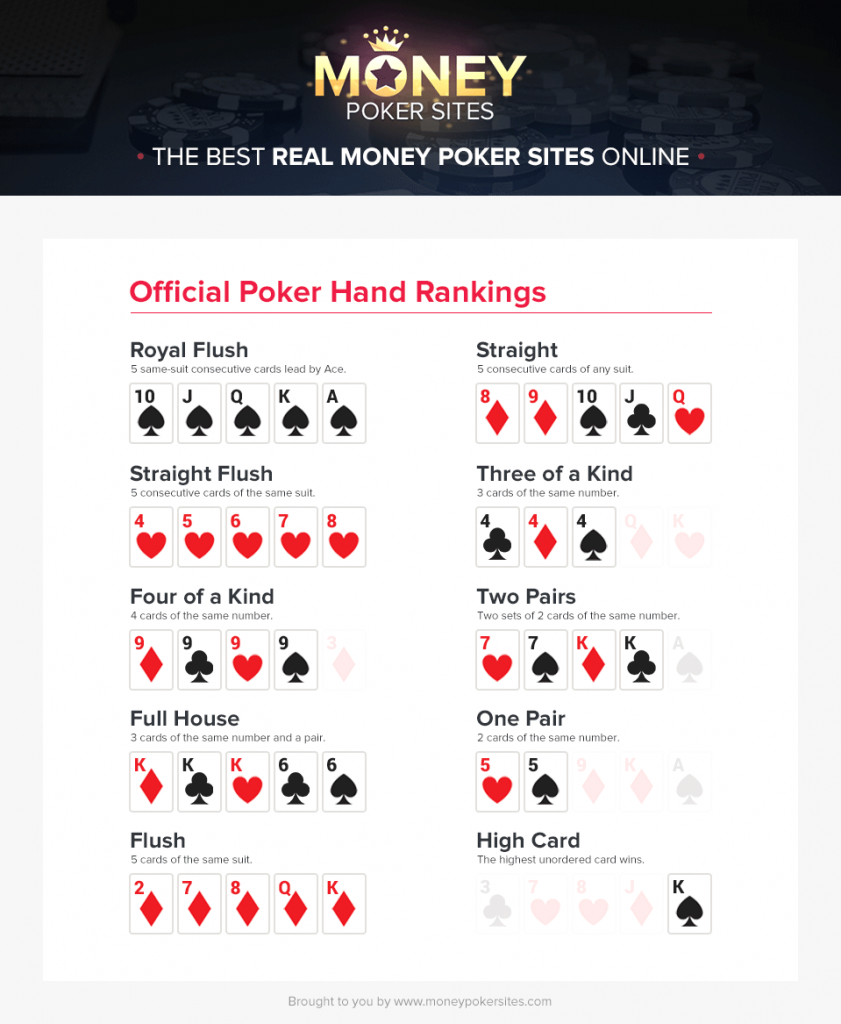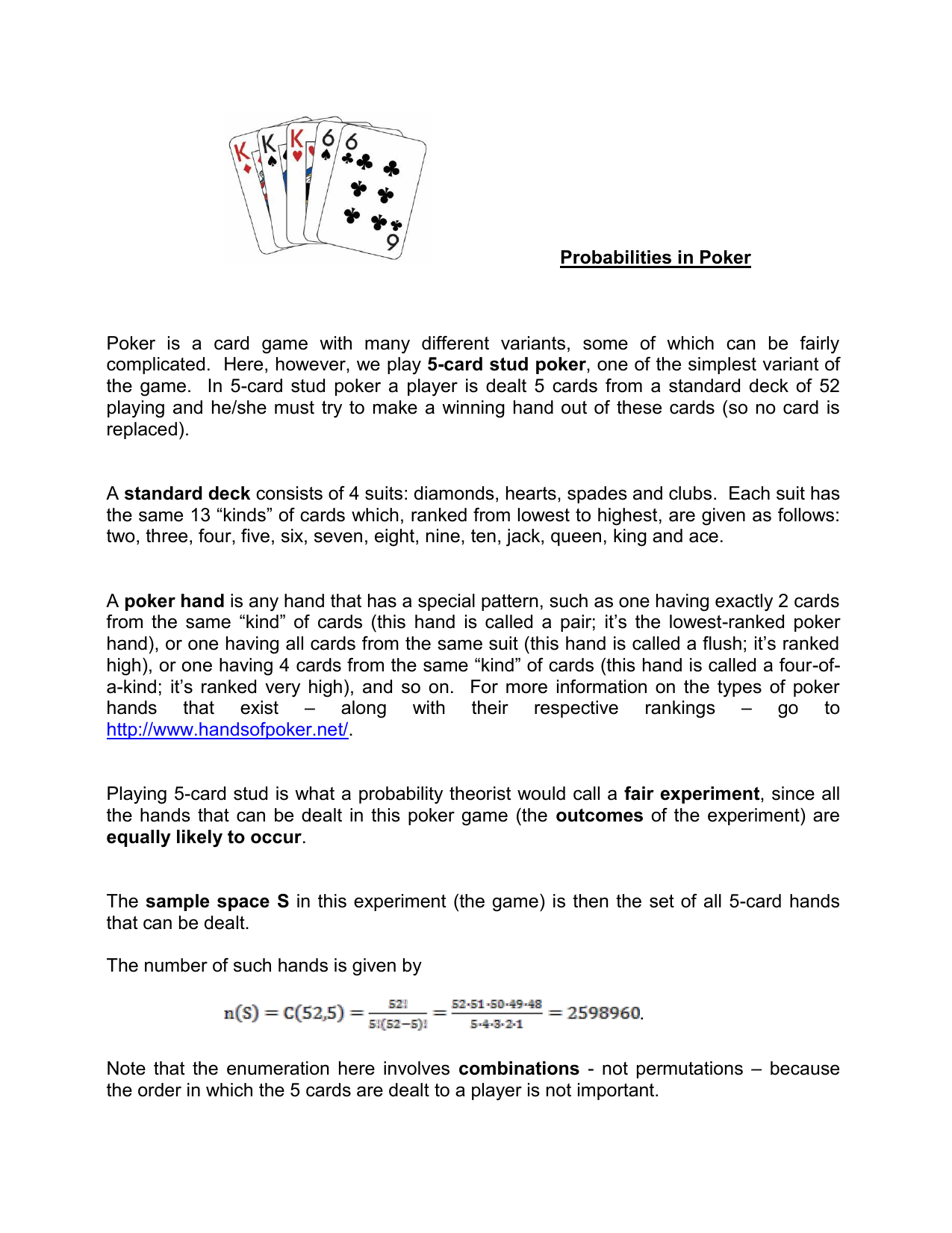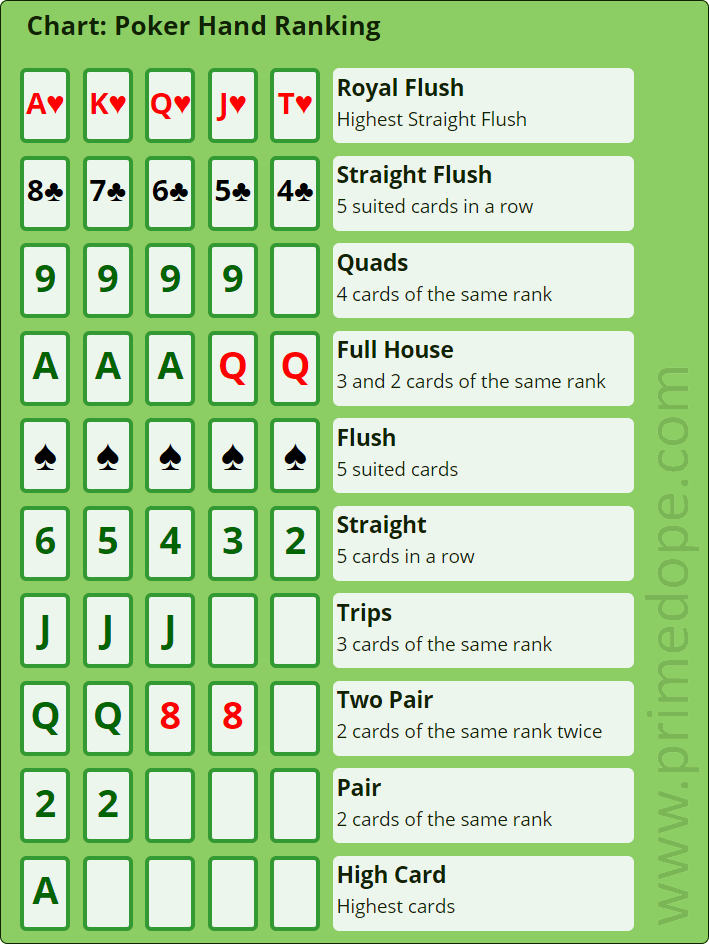Number Of Different Poker Hands
- List Of Poker Hand
- Poker Hands Chart
- Number Of Different Poker Hands Game
- Number Of Different Poker Hands Sanitizer
- Poker Hand Types
Understanding the Different Types of Poker Hands
These are standard hand rankings for most poker games and apply to all high-hand poker variations including Texas Hold'em, Omaha and Stud. You'll find a printable poker hand rankings chart below the hand rankings as well as answers to some of the most frequently asked questions about poker hands and poker hand ranking. Most standard poker games, even the three- and seven-card varieties, only compare the strongest five-card hand the players can build come showdown time. Listed below are all the five-card hands at your disposal: #1 Royal Flush The most difficult hand to come by in poker, the royal flush only has a 0.000154% probability of occurring.
Two Simple Hands
List Of Poker Hand
Strictly speaking, in most standard poker games like Texas Holdem, there are only two types of hands that you should be concerned about: starting hands and the actual five-card poker hands. Let’s take a look at each one below:

Please note the following card references:
(h) Hearts (d) Diamonds (c) Clubs (s) Spades
Starting hands
As the name implies, a starting hand is made up of the initial cards that you are dealt. In games like Texas Holdem, it consists of a pair of cards that you could later on turn into a full five-card poker hand once all community cards are revealed.
Now, while there’s really no way to know for sure whether or not a specific starting hand would turn into a winner come showdown time, seasoned players know, based on experience (and a little bit of math), that certain starting hands have a better chance of building into something strong later in the game over others. These are called premium starting hands. In Texas Holdem, they are as follows:
- AA
- KK
- AK (suited)
- JJ
If you’re a beginner, it would be a good idea to start out only playing when you get any of these starting hands and just folding when you get anything else. Of course, the more games you play and the better you get at strategizing, reading your opponents, and bluffing (which you can learn more about here), the more starting hands you can add to your play list.
Let’s now move on to the next type of poker hands you should familiarize yourself with:
Five-card hands
Most standard poker games, even the three- and seven-card varieties, only compare the strongest five-card hand the players can build come showdown time.
Listed below are all the five-card hands at your disposal:
#1 Royal Flush
The most difficult hand to come by in poker, the royal flush only has a 0.000154% probability of occurring. It is made up of five suited cards of consecutive values and uses an ace its highest card. It is considered the strongest hand in poker.
Ex: Ac Kc Qc Jc 10c
#2 Straight Flush
This hand is pretty much the same as a royal flush. The only difference is that it has a king or lower as its highest card, which is why it only comes second on the list.
Ex: 10s 9s 8s 7s 6s

#3 Four of a Kind
Made up of four same-valued cards and an additional random fifth card, the odds of any player getting this hand are 4,164:1.
Ex: 8d 8h 8s 8c As
#4 Full House
This hand is made up of two parts: a trip and a pair. A trip consists of three cards of the same value while a pair, as you may have figured out by its name, is made up of two same-valued cards.
Ex: 4d 4h 4s 8s 8c
#5 Flush
Remember the straight flush? Well, this hand is pretty much the same thing except that it doesn’t require your card values to be in consecutive order.
Mathematically speaking, there are 5,108 ways you can build a flush with a standard deck of 52 cards. Regardless, the hand is still quite difficult to get. In fact, your odds of doing so are just 508:1.
Ex: Kh 9h 6h 4h 2h
#6 Straight
Another hand that’s derived, if you will, from a straight flush, a straight does not care about the suit of your cards. All you need to build one are five cards of consecutive values.
Ex: Kd Qc Js 10c 9h
#7 Three of a Kind
With a 2.1128% probability of occurring, this hand is essentially just the trip part of a full house plus two additional random cards to complete the set.
Ex: 3h 3s 3c Qd 8s
#8 Two Pair
Remember the pair part of a full house? Well, just take that then add another pair plus one more random card and you have a two pair hand.
Ex: Jd Jh 8d 8c 3s
#9 One Pair
No need for long explanations for this one. It’s just a pair of same-valued cards plus three other random cards to meet the five-card requirement.
Ex: Qd Qh As 3c 2s
#10 High Card
If you can’t build any of the preceding hands, then you get this one by default. It’s made up of just five totally random cards.
Needless to say, it is the weakest hand in poker.
Ex: 10d 8c 7s 5h 3h
You’re now a poker hand type master!
Now, are you ready to enjoy some real money poker action online? Then sign up for a www.safeclub.com account today! And check back again soon for more poker guides, tips and tricks like this one!
In the poker game of Texas hold 'em, a starting hand consists of two hole cards, which belong solely to the player and remain hidden from the other players. Five community cards are also dealt into play. Betting begins before any of the community cards are exposed, and continues throughout the hand. The player's 'playing hand', which will be compared against that of each competing player, is the best 5-card poker hand available from his two hole cards and the five community cards. Unless otherwise specified, here the term hand applies to the player's two hole cards, or starting hand.
Essentials[edit]
There are 1326 distinct possible combinations of two hole cards from a standard 52-card deck in hold 'em, but since suits have no relative value in this poker variant, many of these hands are identical in value before the flop. For example, A♥J♥ and A♠J♠ are identical in value, because each is a hand consisting of an ace and a jack of the same suit.
Therefore, there are 169 non-equivalent starting hands in hold 'em, which is the sum total of : 13 pocket pairs, 13 × 12 / 2 = 78 suited hands and 78 unsuited hands (13 + 78 + 78 = 169).
These 169 hands are not equally likely. Hold 'em hands are sometimes classified as having one of three 'shapes':
- Pairs, (or 'pocket pairs'), which consist of two cards of the same rank (e.g. 9♠9♣). One hand in 17 will be a pair, each occurring with individual probability 1/221 (P(pair) = 3/51 = 1/17).
- Alternative means of making this calculation
- First Step
- As confirmed above.
- There are 1326 possible combination of opening hand.
- Second Step
- There are 6 different combos of each pair. 9h9c, 9h9s, 9h9d, 9c9s, 9c9d, 9d9s. Therefore, there are 78 possible combinations of pocket pairs (6 multiplied by 13 i.e. 22-AA)
- To calculate the odds of being dealt a pair
- 78 (the number of any particular pair being dealt. As above) divided by 1326 (possible opening hands)
- 78/1326 = 0.058 or 5.8%
- Suited hands, which contain two cards of the same suit (e.g. A♣6♣). 23.5% of all starting hands are suited.

Probability of first card is 1.0 (any of the 52 cards)Probability of second hand suit matching the first:There are 13 cards per suit, and one is in your hand leaving 12 remaining of the 51 cards remaining in the deck. 12/51=.2353 or 23.5%
- Offsuit hands, which contain two cards of a different suit and rank (e.g. K♠J♥). 70.6% of all hands are offsuit hands
Offsuit pairs = 78Other offsuit hands = 936
It is typical to abbreviate suited hands in hold 'em by affixing an 's' to the hand, as well as to abbreviate non-suited hands with an 'o' (for offsuit). That is,
- QQ represents any pair of queens,
- KQ represents any king and queen,
- AKo represents any ace and king of different suits, and
- JTs represents any jack and ten of the same suit.
Limit hand rankings[edit]
Some notable theorists and players have created systems to rank the value of starting hands in limit Texas hold'em. These rankings do not apply to no limit play.
Sklansky hand groups[edit]
David Sklansky and Mason Malmuth[1] assigned in 1999 each hand to a group, and proposed all hands in the group could normally be played similarly. Stronger starting hands are identified by a lower number. Hands without a number are the weakest starting hands. As a general rule, books on Texas hold'em present hand strengths starting with the assumption of a nine or ten person table. The table below illustrates the concept:
Chen formula[edit]

The 'Chen Formula' is a way to compute the 'power ratings' of starting hands that was originally developed by Bill Chen.[2]
- Highest Card
- Based on the highest card, assign points as follows:
- Ace = 10 points, K = 8 points, Q = 7 points, J = 6 points.
- 10 through 2, half of face value (10 = 5 points, 9 = 4.5 points, etc.)
- Pairs
- For pairs, multiply the points by 2 (AA=20, KK=16, etc.), with a minimum of 5 points for any pair. 55 is given an extra point (i.e., 6).
- Suited
- Add 2 points for suited cards.
- Closeness
- Subtract 1 point for 1 gappers (AQ, J9)
- 2 points for 2 gappers (J8, AJ).
- 4 points for 3 gappers (J7, 73).
- 5 points for larger gappers, including A2 A3 A4
Poker Hands Chart
- Add an extra point if connected or 1-gap and your highest card is lower than Q (since you then can make all higher straights)

Number Of Different Poker Hands Game
Phil Hellmuth's: 'Play Poker Like the Pros'[edit]
Phil Hellmuth's 'Play Poker Like the Pros' book published in 2003.
| Tier | Hands | Category |
|---|---|---|
| 1 | AA, KK, AKs, QQ, AK | Top 12 Hands |
| 2 | JJ, TT, 99 | |
| 3 | 88, 77, AQs, AQ | |
| 4 | 66, 55, 44, 33, 22, AJs, ATs, A9s, A8s | Majority Play Hands |
| 5 | A7s, A6s, A5s, A4s, A3s, A2s, KQs, KQ | |
| 6 | QJs, JTs, T9s, 98s, 87s, 76s, 65s | Suited Connectors |
Statistics based on real online play[edit]
Statistics based on real play with their associated actual value in real bets.[3]
| Tier | Hands | Expected Value |
|---|---|---|
| 1 | AA, KK, QQ, JJ, AKs | 2.32 - 0.78 |
| 2 | AQs, TT, AK, AJs, KQs, 99 | 0.59 - 0.38 |
| 3 | ATs, AQ, KJs, 88, KTs, QJs | 0.32 - 0.20 |
| 4 | A9s, AJ, QTs, KQ, 77, JTs | 0.19 - 0.15 |
| 5 | A8s, K9s, AT, A5s, A7s | 0.10 - 0.08 |
| 6 | KJ, 66, T9s, A4s, Q9s | 0.08 - 0.05 |
| 7 | J9s, QJ, A6s, 55, A3s, K8s, KT | 0.04 - 0.01 |
| 8 | 98s, T8s, K7s, A2s | 0.00 |
| 9 | 87s, QT, Q8s, 44, A9, J8s, 76s, JT | (-) 0.02 - 0.03 |
Nicknames for starting hands[edit]
In poker communities, it is common for hole cards to be given nicknames. While most combinations have a nickname, stronger handed nicknames are generally more recognized, the most notable probably being the 'Big Slick' - Ace and King of the same suit, although an Ace-King of any suit combination is less occasionally referred to as an Anna Kournikova, derived from the initials AK and because it 'looks really good but rarely wins.'[4][5] Hands can be named according to their shapes (e.g., paired aces look like 'rockets', paired jacks look like 'fish hooks'); a historic event (e.g., A's and 8's - dead man's hand, representing the hand held by Wild Bill Hickok when he was fatally shot in the back by Jack McCall in 1876); many other reasons like animal names, alliteration and rhyming are also used in nicknames.
Number Of Different Poker Hands Sanitizer
Notes[edit]
- ^David Sklansky and Mason Malmuth (1999). Hold 'em Poker for Advanced Players. Two Plus Two Publications. ISBN1-880685-22-1
- ^Hold'em Excellence: From Beginner to Winner by Lou Krieger, Chapter 5, pages 39 - 43, Second Edition
- ^http://www.pokerroom.com/poker/poker-school/ev-stats/total-stats-by-card/[dead link]
- ^Aspden, Peter (2007-05-19). 'FT Weekend Magazine - Non-fiction: Stakes and chips Las Vegas and the internet have helped poker become the biggest game in town'. Financial Times. Retrieved 2010-01-10.
- ^Martain, Tim (2007-07-15). 'A little luck helps out'. Sunday Tasmanian. Retrieved 2010-01-10.